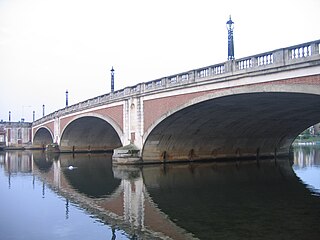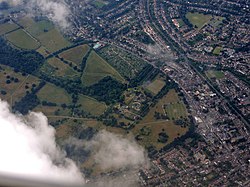
Hampton is a suburb of Greater London on the north bank of the River Thames, in the London Borough of Richmond upon Thames, England, and the historic county of Middlesex. Hampton is bounded by Bushy Park to the east, the suburbs of Hampton Hill and Fulwell to the north, green belt to the west, and the Thames to the south.

Supreme Headquarters Allied Expeditionary Force was the headquarters of the Commander of Allied forces in northwest Europe, from late 1943 until the end of World War II. US General Dwight D. Eisenhower was the commander in SHAEF throughout its existence. The position itself shares a common lineage with Supreme Allied Commander Europe and Atlantic, but they are different titles.

Teddington Lock is a complex of three locks and a weir on the River Thames between Ham and Teddington in the London Borough of Richmond upon Thames, England. Historically in Middlesex, it was first built in 1810.

Hampton Wick is a Thamesside area of the London Borough of Richmond upon Thames, England, contiguous with Teddington, Kingston upon Thames and Bushy Park.

Twickenham is a constituency in Greater London represented in the House of Commons of the UK Parliament since 2019 by Munira Wilson of the Liberal Democrats.

Hampton Court Park, also known as Home Park, is a walled royal park managed by the Historic Royal Palaces. The park lies between the gardens of Hampton Court Palace and Kingston upon Thames and Surbiton in south west London, England, mostly within the post town of East Molesey, but with its eastern extremity within the post town of Kingston. In 2014, part of the park was designated a biological Site of Special Scientific Interest. It takes up most of the final (lowest) meander of the non-tidal reaches of the River Thames and is mainly divided between a golf course, meadows interspersed with trees used for deer, seasonal horse grazing and wildlife. A corner of the park is used annually for the Hampton Court Flower Show and the part nearest to the palace has the Long Water — an early set of hydro-engineered ponds or lakes, fed by water from the distant River Colne, as are the bodies of water in the neighbouring park, Bushy Park.

Molesey is a suburban district comprising two villages, East Molesey and West Molesey, in the Borough of Elmbridge, Surrey, England, and is situated on the south bank of the River Thames.

Hampton Court Bridge is a Grade II listed bridge that crosses the River Thames in England approximately north–south between Hampton, London and East Molesey, Surrey, carrying the A309. It is the upper of two road bridges on the reach above Teddington Lock and downstream of Molesey Lock.

The A308 is a road in England in two parts. The first part runs from Central London to Putney Bridge. The second part runs from just beyond Putney Heath to Bisham, Berkshire. It traces four, roughly straight lines, to stay no more than 3 miles (4.8 km) from the Thames. It is a dual carriageway where it is furthest from that river, in Spelthorne, Surrey and forms one of the motorway spurs to the large town of Maidenhead. Other key settlements served are Fulham, Kingston (London), Staines upon Thames, Windsor and a minor approach to Marlow

Hampton Hill is a district in the London Borough of Richmond upon Thames to the south of Twickenham. It is bounded by Fulwell and Twickenham Golf Courses to the northwest; a railway line road bridge at the junction of Wellington Road and Clonmel Road; a line southward just east of Wellington Road; Bushy Park to the southeast; and the artificial Longford River to the south and west. Hampton Hill is served by Fulwell railway station and Hampton railway station on the Shepperton to Waterloo line. It is part of what is collectively known as The Hamptons. Much of Hampton Hill High Street, and some neighbouring residential areas are designated as a conservation area.

The Longford River is an artificial waterway, a distributary designed to embellish a park, that diverts water 12 miles (19 km) from the River Colne at Longford near Colnbrook in England, to Bushy Park and Hampton Court Palace. Its main outlet is to the reach above Molesey Lock with lesser pond outlet channels to that above Teddington Lock. The waterway was built for King Charles I in 1638/39 as a water supply for Hampton Court. Water features in Bushy Park were added in 1710. North of the A30, its course has been diverted more than once as London Heathrow Airport has grown. Its cascades, grassed banks and fountains in Bushy Park were restored and reopened to the public in 2009 to close to their original state.

Bushy House is a Grade II* listed former residence of King William IV and Queen Adelaide in Teddington, London, which Lord Halifax had constructed for his own enjoyment on the site of a previous house Upper Lodge, Bushy Park, between 1714 and 1715.

The A309 is a mostly primary status A-road that runs in two sections, a short section in Twickenham and Teddington as a non-primary status A-road, as well as the much longer primary A- Road section that runs from Hampton Court to Hook.

Teddington is an affluent suburb of London in the London Borough of Richmond upon Thames. Historically an ancient parish in the county of Middlesex and situated close to the border with Surrey, the district became part of Greater London in 1965. In 2021, The Sunday Times named Teddington as the best place to live in London.

Camp Griffiss was a US military base in the United Kingdom during and after World War II. Constructed within the grounds of Bushy Park in Middlesex,, England, it served as the European Headquarters for the United States Army Air Forces from July 1942 to December 1944. From here Dwight D. Eisenhower planned the D-Day invasion. Most of the camp's huts had been removed by the early 1960s, and a memorial tablet now stands on the site.

The Diana Fountain in Bushy Park, in the London Borough of Richmond upon Thames, England, is a seventeenth-century statue ensemble and water feature in an eighteenth-century setting with a surrounding pool and mile long tree lined vistas which honors the Roman Goddess Diana. Originally created for Somerset House in the 1630s, and remodelled about 1690, the fountain has stood since 1713 in Bushy Park, and now forms a large traffic island in Chestnut Avenue.

Sacred Heart Church is a Roman Catholic church and parish in Teddington, southwest London, that serves the Catholic community of Teddington and Hampton Wick. It is in the Upper Thames Deanery of the Roman Catholic Archdiocese of Westminster and is situated at 262 Kingston Road, approximately midway between the junctions with Kingston Bridge and Teddington Lock Footbridge.
St Albans Riverside is a park in Hampton in the London Borough of Richmond upon Thames. It is linear with long sides between the Thames and Hampton Court Road. It runs from southeast of Garrick's Villa and his Temple to Shakespeare, Garrick's Lawn, Thames Street to a point 90 metres southeast of the interrupting small bridge that serves Tagg's Island.


























